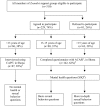Enhancing psychosocial support for HIV positive adolescents in Harare, Zimbabwe
- PMID: 23894625
- PMCID: PMC3720910
- DOI: 10.1371/journal.pone.0070254
Enhancing psychosocial support for HIV positive adolescents in Harare, Zimbabwe
Abstract
Background: There is a recognized gap in the evidence base relating to the nature and components of interventions to address the psycho-social needs of HIV positive young people. We used mixed methods research to strengthen a community support group intervention for HIV positive young people based in Harare, Zimbabwe.
Methods: A quantitative questionnaire was administered to HIV positive Africaid support group attendees. Afterwards, qualitative data were collected from young people aged 15-18 through tape-recorded in-depth interviews (n=10), 3 focus group discussions (FGDs) and 16 life history narratives. Data were also collected from caregivers, health care workers, and community members through FGDs (n=6 groups) and in-depth interviews (n=12). Quantitative data were processed and analysed using STATA 10. Qualitative data were analysed using thematic analysis.
Results: 229/310 young people completed the quantitative questionnaire (74% participation). Median age was 14 (range 6-18 years); 59% were female. Self-reported adherence to antiretrovirals was sub-optimal. Psychological well being was poor (median score on Shona Symptom Questionnaire 9/14); 63% were at risk of depression. Qualitative findings suggested that challenges faced by positive children include verbal abuse, stigma, and discrimination. While data showed that support group attendance is helpful, young people stressed that life outside the confines of the group was more challenging. Caregivers felt ill-equipped to support the children in their care. These data, combined with a previously validated conceptual framework for family-centred interventions, were used to guide the development of the existing programme of adolescent support groups into a more comprehensive evidence-based psychosocial support programme encompassing caregiver and household members.
Conclusions: This study allowed us to describe the lived experiences of HIV positive young people and their caregivers in Zimbabwe. The findings contributed to the enhancement of Africaid's existing programme of support to better promote psychological well being and ART adherence.
Conflict of interest statement
Figures


References
-
- UNAIDS (2012) Regional Fact Sheet 2012. Geneva: UNAIDS.
-
- Cavarelli M, Scarlatti G (2011) Human immunodeficiency virus type 1 mother-to-child transmission and prevention: successes and controversies. J Intern Med 270: 561–579. - PubMed
-
- UNAIDS (2011) UNAIDS World AIDS Day Report; How to get to zero: Faster, Smarter, Better. Geneva: UNAIDS.
-
- UNAIDS (2009) AIDS Epidemic Update. Geneva Joint United Nations Programme on HIV/AIDS.
-
- UNAIDS (2012) Report on the Global AIDS Epidemic. Geneva: UNAIDS.
Publication types
MeSH terms
Grants and funding
LinkOut - more resources
Full Text Sources
Other Literature Sources
Medical
Miscellaneous

